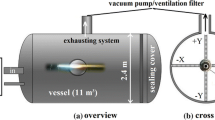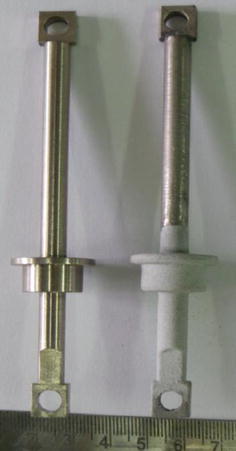Abstract
Argon plasma treatment of 316 stainless steel surface showed improved surface area and electrical conductivity. The effect of plasma etching time and plasma voltage on the production rate of oxyhydrogen (HHO) fuel in an electrolytic cell was studied. The plasma voltage of 2000 V and etching time of 60 min increased the fuel production rate by about 100%. The results are considered in light of the increase in surface area and the change in the relative mass ratio of surface metals due to plasma etching. A simple model is used to calculate the pore depth. The etching time is limited, so the pore size does not exceed the gas bubble size.




Similar content being viewed by others
References
M.S. Opu, Effect of operating parameters on performance of alkaline water electrolysis. Int. J. Therm. Environ. Eng 9, 53–60 (2015)
R. Kothari, D. Buddhi, R. Sawhney, Optimization of electrolytic input power for the production of hydrogen. Int. J. Hydrogen Energy 31(15), 2329–2336 (2006)
R. Kothari, D. Buddhi, R. Sawhney, Studies on the effect of temperature of the electrolytes on the rate of production of hydrogen. Int. J. Hydrogen Energy 30(3), 261–263 (2005)
O. Bičáková, P. Straka, Production of hydrogen from renewable resources and its effectiveness. Int. J. Hydrogen Energy 37(16), 11563–11578 (2012)
I. Dincer, Green methods for hydrogen production. Int. J. Hydrogen Energy 37(2), 1954–1971 (2012)
E. Bozoglan, A. Midilli, A. Hepbasli, Sustainable assessment of solar hydrogen production techniques. Energy 46(1), 85–93 (2012)
G. Marbán, T. Valdés-Solís, Towards the hydrogen economy? Int. J. Hydrogen Energy 32(12), 1625–1637 (2007)
M. Jiang, D. Zhu, X. Zhao, Electrolysis of ammonia for hydrogen production catalyzed by Pt and Pt-Ir deposited on nickel foam. J. Energy Chem. 23(1), 1–8 (2014)
I. Vincent, E.-C. Lee, H.-M. Kim, Comprehensive impedance investigation of low-cost anion exchange membrane electrolysis for large-scale hydrogen production. Sci. Rep. 11(1), 1–12 (2021)
M.A. Khan, H. Zhao, W. Zou, Z. Chen, W. Cao, J. Fang, J. Zhang, Recent progresses in electrocatalysts for water electrolysis. Electrochem. Energy Rev. 1(4), 483–530 (2018)
M.J. Lavorante, J.I. Franco, Performance of stainless steel 316L electrodes with modified surface to be use in alkaline water electrolyzers. Int. J. Hydrogen Energy 41(23), 9731–9737 (2016)
A. Nassar, E. Nassar, Corrosion behaviour of some conventional stainless steels in electrolyzing process. Leonardo Electron. J. Pract. Technol. 14(27), 120–130 (2015)
A.N. Colli, H.H. Girault, A. Battistel, Non-precious electrodes for practical alkaline water electrolysis. Materials 12(8), 1336 (2019)
J. Olivares-Ramírez, M. Campos-Cornelio, J.U. Godínez, E. Borja-Arco, R. Castellanos, Studies on the hydrogen evolution reaction on different stainless steels. Int. J. Hydrogen Energy 32(15), 3170–3173 (2007)
K. Seshan, Handbook of thin film deposition. William Andrew (2012)
B. Łosiewicz, M. Popczyk, M. Szklarska, & P. Osak, Effect of phosphorus on the corrosion resistance of nickel electrocoatings. Paper presented at the Solid State Phenomena (2015)
Acknowledgements
The authors would like to thank the Deanship of Scientific Research at Umm Al-Qura University for supporting this work by Grant Code: (22UQU4310414DSR01).
Author information
Authors and Affiliations
Corresponding author
Rights and permissions
Springer Nature or its licensor holds exclusive rights to this article under a publishing agreement with the author(s) or other rightsholder(s); author self-archiving of the accepted manuscript version of this article is solely governed by the terms of such publishing agreement and applicable law.
About this article
Cite this article
Zayed, O., El-Gammam, Y.A. & Fteiti, M. Plasma-enhanced electrode for hydro-oxy fuel generators. Eur. Phys. J. Spec. Top. (2022). https://doi.org/10.1140/epjs/s11734-022-00668-6
Received:
Accepted:
Published:
DOI: https://doi.org/10.1140/epjs/s11734-022-00668-6




